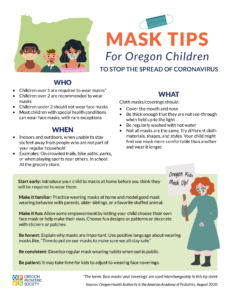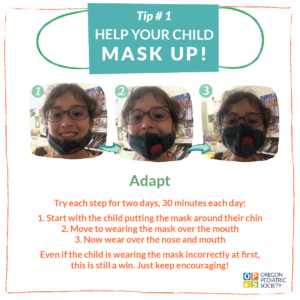Policy Statement on Universal Masking At Schools
[July 29, 2021] The Oregon Pediatric Society and the Oregon Academy of Family Physicians strongly advocate for in-person learning in K-12 classrooms, while taking disease-preventing pandemic safety measures. To keep kids healthy and prevent quarantines, we urge Oregon ’s school districts to follow the Governor’s July 29 masking directive and mandate universal masking inside schools immediately.
Updated Guidance: The American Academy of Pediatrics’ Interim COVID-19 Guidance for Safe Schools (7/18/21)
Trending Questions on Masks & Kids
Should children wear masks to schools?
“To keep students as safe possible in school, in addition to other key safety recommendations, everyone over age 2 years should wear face masks that cover the nose and mouth. This is a simple, proven tool to protect students unable to get the vaccine yet or who have chosen not to get it.
When they fit well and are worn correctly and consistently, face masks are effective and safe to wear for long periods of time such as during the school day. The vast majority of children, even those with medical conditions, are able to safely and effectively wear face masks with practice, support and role-modeling by adults. Talk with your child’s pediatrician about certain medical and developmental conditions that would prohibit mask use.” – the American Academy of Pediatrics
Is double masking (wearing two masks) helpful?
Researchers from the Centers for Disease Control and Prevention (CDC) have evaluated ways to improve the fit and filtration of masks, including double masking. Read on for an brief summary of experimental research findings.
Can wearing a mask make it harder for my child to breathe?
“There have been concerns that cloth face coverings can reduce oxygen intake, and can lead to low blood oxygen levels, known as hypoxemia. However, cloth masks are made from breathable materials that will not block the oxygen your child needs. The vast majority of children age 2 or older can safely wear a cloth face covering for extended periods of time, such as the school day or at child care. This includes children with many medical conditions.”– American Academy of Pediatrics
Do masks trap the carbon dioxide that we normally breathe out?
“No. There have been false reports that cloth face coverings can lead to carbon dioxide poisoning (known as hypercapnia) from re-breathing the air we normally breathe out. But this is not true. Carbon dioxide molecules are very tiny, even smaller than respiratory droplets. They cannot be trapped by breathable materials like cloth masks. In fact, surgeons wear tight fitting masks all day as part of their jobs, without any harm.” – American Academy of Pediatrics
Do masks delay speech and language development?
A key part of learning to communicate for a child is watching the faces, mouths, and expressions of the people closest to them. Babies and young children study faces intently, so the concern about solid masks covering the face is understandable. However, there are no known studies that use of a face mask negatively impacts a child’s speech and language development.
And consider this: visually impaired children develop speech and language skills at the same rate as their peers. In fact, when one sense is taken away, the others may be heightened. Young children will use other clues provided to them to understand and learn language. They will watch gestures, hear changes in tone of voice, see eyes convey emotions, and listen to words. – American Academy of Pediatrics
Read on for tips on boosting your child’s communication skills as face masks continue.
Will masks hinder my child's lung development?
Wearing a face mask will not affect your child’s lungs from developing normally. This is because oxygen flows through and around the mask, while blocking the spray of spit and respiratory droplets that may contain the virus. Keeping your child’s lungs healthy is important, which includes preventing infections like COVID-19. – the American Academy of Pediatrics
What if masks are scaring my child?
“For children under 3, it’s best to answer their questions simply in language they understand. If they ask about why people are wearing cloth face coverings, explain that sometimes people wear them when they are sick, and sometimes people wear them so they don’t get sick.
For children over 3, try focusing on germs. Explain that germs are special to your own body. Some germs are good and some are bad. The bad ones can make you sick. Since we can’t always tell which are good or bad, the cloth face coverings help make sure you keep those germs away from your own body.
Children and teens often struggle when they feel different. They may feel that wearing a mask stereotypes them as being sick. As more people wear cloth face coverings, children will get used to them and not feel singled out or strange about wearing them. It will quickly become the “new normal” for children and teens.” – American Academy of Pediatrics
How can my child prevent foggy glasses when wearing a mask?
Pediatric ophthalmologists recommend:
- Be sure the mask has a tight fit on the nose. If your child’s mask does not have a wire band to make a tight fit, you can use soft tape along the bridge of the nose and the mask.
- The glasses should be worn slightly forward so the nose piece of the glasses is over the mask to help push down on the mask to prevent the glasses from fogging up.
More Helpful Information for Families:
Safe Schools During the COVID-19 Pandemic (healthychildren.org)
Mask Mythbusters: Common Questions about Kids & Face Masks (healthychildren.org)
Advice from Oregon Pediatricians
Kids & Masks: The Why & How – Rob McRae, MD, Joanna Odenthal, MD, and Ellen Stevenson, MD
From “No” to Masking Pro: Helping Your Hesitant Child Mask Up – Dr. Elizabeth Super, MD
Rumors I’ve heard about COVID-19 – Myth or Fact? – Megan Jacobs, MD, MSCS and Jessica Serrano, MD, MPH
Shareable Graphics & Resources
Mask Tip Sheet for Oregon Children ………………………………………………………………..
Set of 5 social media graphics with kid masking strategies from Oregon Pediatrician Elizabeth Super, MD.
Masking Guidance
Cloth Face Coverings for Children during COVID-19 (American Academy of Pediatrics)
Kids and Masks: Why Cloth Face Coverings Are Needed in Youth Sports During COVID-19 (American Academy of Pediatrics)
Interim Guidance for Face Masks (American Academy of Pediatrics)
Guidance for Wearing Masks (CDC)
Toolkit for Helping Children Wear Masks During COVID-19 – Available in multiple languages (University of Rochester Medical Center)
Oregon Kids Who Mask
.
“We first had Easton (age 2) try to wear a mask at a berry picking farm that had strict regulations that all participants needed to have masks on, ” his father said. “It was a total nightmare since he had never experienced wearing a mask before. After that, we took a slow, step-wise approach to mask wearing. It took a few weeks, but now wearing a mask in public spaces is second nature to him. His Mickey Mouse mask is his favorite.”
.
.
.
.
.
Over the summer, Katherine (age 9) and Kincade (age 7) rocked their face coverings at an outdoor day camp. “I wear my mask at day camp because it slows down the spread of the virus,” Katherine said. “My mask lets me go places, like camp. It keeps me and others from catching COVID!”
.
..
.
.
.
Eitu (age 7) and Emma (age 5) mask up when heading to the park with their little brother, Liór.
.
.
.
.
.
“Jack (age 4) is going through a hardcore aviation phase, so we practically live at the Evergreen Aviation & Space Museum these days,” his mother said. “Jack has Sensory Processing Disorder, and wearing a mask was very difficult at first. To help him embrace it, we showed him pictures of jet pilots wearing their facial gear, and used his desire to be a pilot to role play until he was comfortable enough to wear it without the game. The volunteers at the museum are largely retired veterans, so he loves to show them his ‘uniform.'”
.



